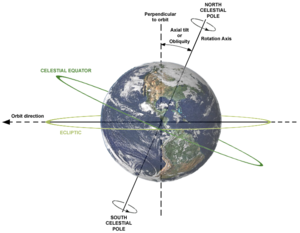
Back Hemelpool Afrikaans قطب سماوي Arabic Polu celeste AST Pol celeste Catalan Nebeský pól Czech Himmelspol German Ουράνιος πόλος Greek Polo celeste Spanish Taevapoolus Estonian Zeru polo Basque
This article needs additional citations for verification. (March 2013) |


The north and south celestial poles are the two points in the sky where Earth's axis of rotation, indefinitely extended, intersects the celestial sphere. The north and south celestial poles appear permanently directly overhead to observers at Earth's North Pole and South Pole, respectively. As Earth spins on its axis, the two celestial poles remain fixed in the sky, and all other celestial points appear to rotate around them, completing one circuit per day (strictly, per sidereal day).
The celestial poles are also the poles of the celestial equatorial coordinate system, meaning they have declinations of +90 degrees and −90 degrees (for the north and south celestial poles, respectively). Despite their apparently fixed positions, the celestial poles in the long term do not actually remain permanently fixed against the background of the stars. Because of a phenomenon known as the precession of the equinoxes, the poles trace out circles on the celestial sphere, with a period of about 25,700 years. The Earth's axis is also subject to other complex motions which cause the celestial poles to shift slightly over cycles of varying lengths (see nutation, polar motion and axial tilt). Finally, over very long periods the positions of the stars themselves change, because of the stars' proper motions. To take into account such movement, celestial pole definitions come with an epoch to specify the date of the rotation axis; J2000.0 is the current standard.
An analogous concept applies to other planets: a planet's celestial poles are the points in the sky where the projection of the planet's axis of rotation intersects the celestial sphere. These points vary because different planets' axes are oriented differently (the apparent positions of the stars also change slightly because of parallax effects).[1]
- ^ Jim Kaler Professor Emeritus of Astronomy, University of Illinois. "Measuring the sky A quick guide to the Celestial Sphere". Retrieved 10 March 2014.